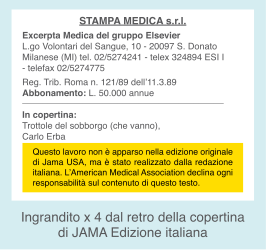
"La sopravvivenza a condizioni sfavorevoli richiede una capacità di adattamento che fornisce i migliori risultati quando le modifiche sono massimamente funzionali al nuovo ambiente creatosi.”
La contrazione delle risorse, unitamente a pratiche più rigorose nella valutazione della efficacia dei farmaci ha rappresentato un forte stimolo al cambiamento per l’Industria farmaceutica, che muta le proprie strategie di marketing adattandole alle nuove regole ed alla diversa recettività dei medici “prescrittori”.
 stri” della comunicazione. Oggi questo veicolo informativo è meno utilizzato: il tavolo del medico si popola comunque di carta stampata, ma si tratta di depliant in genere più sobri, le ridicole grossolanità del passato si avviano a diventare rarità da modernariato che non mancheremo di segnalare, come dimostrano i due casi commentati in questo stesso numero, quando ancora così attuali. Anche le inserzioni nelle riviste più o meno “importanti” sono andate riducendosi parallelamente alla diffusione della lettura sui supporti informatici dove le pagine di “pubblicità” non compaiono nel pdf. Anche gli Informatori Medico Scientifici si sono rarefatti: invertendo il processo di proliferazione delle “linee”, le Aziende tendono a ridurre il personale puntando su altri mezzi di penetrazione nelle penne dei “prescrittori”. Proliferano le riviste elettroniche alle quali è affidata l’eredità diretta della vecchia dis-informazione, ma la stirpe dei “mostri informativi” ha avuto ben altra evoluzione. Un esempio lampante è (stata?) la comunicazione verbale cioè istigare alla prescrizione “off-label” cioè per indicazioni non approvate e quindi non incluse nella scheda tecnica: “…lo provi, Dottore….si faccia la Sua esperienza…”. Per smascherare ed isolare questo “mostro” si sono attivati i Medici di Famiglia francesi che registravano le comunicazioni incriminate ed alcune testimonianze di Informatori farmaceutici hanno portato a diverse condanne a carico di varie ditte responsabili di avere orchestrato una precisa strategia volta alla induzione di prescrizioni off-label1, 2. Se la medicina basata sulle prove di efficacia ha condotto a nuove consapevolezze e convinto numerosi medici a leggere gli studi, seguire linee guida e documenti di consenso, questo ha automaticamente attratto a sé l’interesse delle strategie di comunicazione dell’Industria. Come dire che, se i Medici chiedono “evidenze”, “raccomandazioni” o “revisioni serie”, questo deve essere il veicolo da impiegare per influire sulle loro scelte. Ovvero: volete le Linee Guida ? eccovele….
stri” della comunicazione. Oggi questo veicolo informativo è meno utilizzato: il tavolo del medico si popola comunque di carta stampata, ma si tratta di depliant in genere più sobri, le ridicole grossolanità del passato si avviano a diventare rarità da modernariato che non mancheremo di segnalare, come dimostrano i due casi commentati in questo stesso numero, quando ancora così attuali. Anche le inserzioni nelle riviste più o meno “importanti” sono andate riducendosi parallelamente alla diffusione della lettura sui supporti informatici dove le pagine di “pubblicità” non compaiono nel pdf. Anche gli Informatori Medico Scientifici si sono rarefatti: invertendo il processo di proliferazione delle “linee”, le Aziende tendono a ridurre il personale puntando su altri mezzi di penetrazione nelle penne dei “prescrittori”. Proliferano le riviste elettroniche alle quali è affidata l’eredità diretta della vecchia dis-informazione, ma la stirpe dei “mostri informativi” ha avuto ben altra evoluzione. Un esempio lampante è (stata?) la comunicazione verbale cioè istigare alla prescrizione “off-label” cioè per indicazioni non approvate e quindi non incluse nella scheda tecnica: “…lo provi, Dottore….si faccia la Sua esperienza…”. Per smascherare ed isolare questo “mostro” si sono attivati i Medici di Famiglia francesi che registravano le comunicazioni incriminate ed alcune testimonianze di Informatori farmaceutici hanno portato a diverse condanne a carico di varie ditte responsabili di avere orchestrato una precisa strategia volta alla induzione di prescrizioni off-label1, 2. Se la medicina basata sulle prove di efficacia ha condotto a nuove consapevolezze e convinto numerosi medici a leggere gli studi, seguire linee guida e documenti di consenso, questo ha automaticamente attratto a sé l’interesse delle strategie di comunicazione dell’Industria. Come dire che, se i Medici chiedono “evidenze”, “raccomandazioni” o “revisioni serie”, questo deve essere il veicolo da impiegare per influire sulle loro scelte. Ovvero: volete le Linee Guida ? eccovele….Bibliografia
1. Landefeld CS, Steinman MA The Neurontin legacy--marketing through misinformation and manipulation. N Engl J Med. 2009; 360: 103-6.
2. Vedula SS et al Outcome reporting in industry-sponsored trials of gabapentin for off-label use. N Engl J Med. 2009; 361:1963-71
3. Choudhry NK et al. Relationships between authors of clinical practice guidelines and the pharmaceutical industry. JAMA. 2002; 287: 612-17.
4. ESC Task Force Focused update of the ESC Guidelines for the management of atrial fibrillation Eur Heart J (2012) 33, 2719–2747
5. Nelson HD et al. Screening for osteoporosis: an update for the U.S. Preventive Services Task Force. Ann Intern Med. 2010; 153: 99-111.
6. U.S. Preventive Services Task Force. Screening for osteoporosis: U.S. preventive services task force recommendation statement. Ann Intern Med. 2011; 154: 356-64
7. Davidson RA. Sources of funding and outcomes of clinical trials. J Gen Intern Med. 1996; 1: 1550–1558
8. Ross JS et al Guest authorship and ghostwriting in publications related to rofecoxib: a case study of industry documents from rofecoxib litigation. JAMA. 2008; 299: 1800-12.
9. McClung MR et al. Effect of risedronate on the risk of hip fracture in elderly women N Engl J Med. 2001; 344: 333-40.
10.Shepherd J et al. Pravastatin in elderly individuals at risk of vascular disease (PROSPER): a randomised controlled trial. Lancet. 2002; 360: 1623-30.
Data di Redazione 04/2013